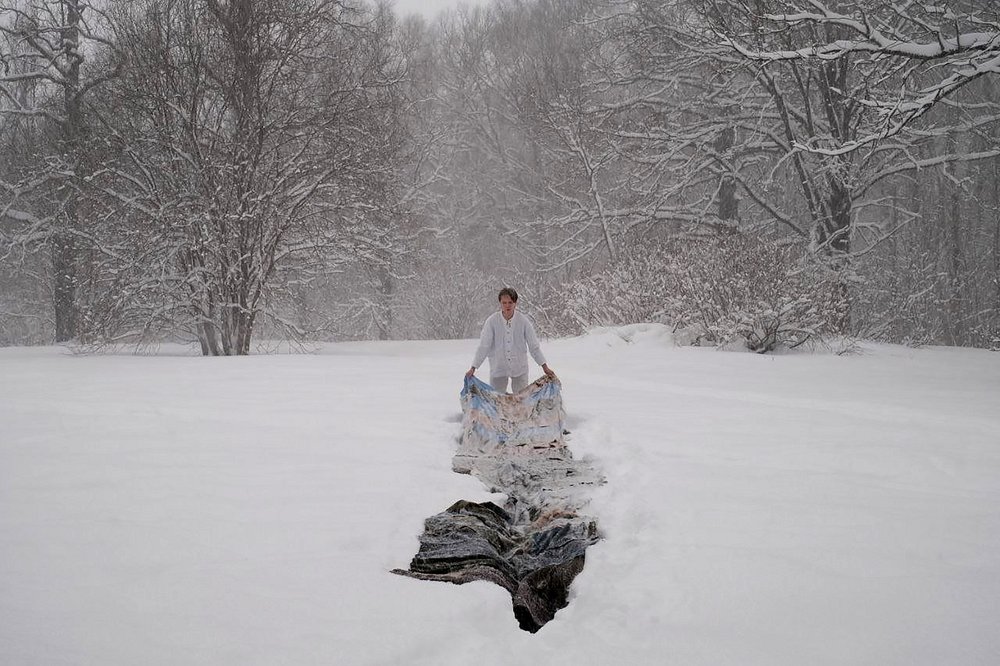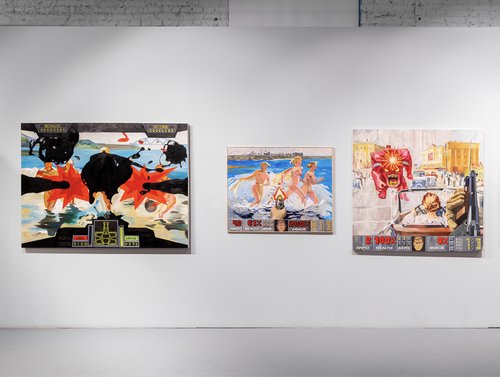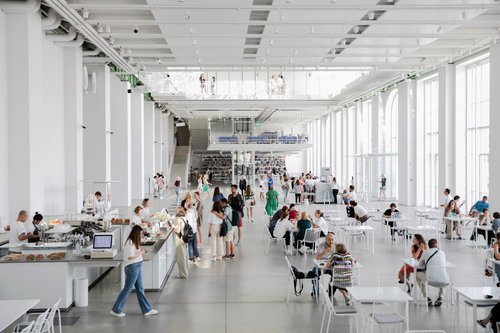What Is Hidden beyond the Borders of Vision?

Anna Lapshinova. The Appian Road, 2024. Exhibition 'Limits of Visibility'. Courtesy of Winzavod Centre for Contemporary Art
‘Limits of Visibility’ an exhibition curated by Sergey Khachaturov at Winzavod Art Centre in Moscow challenges how we see art through optical phenomena and blind spots, featuring work by fifty artists which explore the boundaries of our visual perception.
While inflation plagues the world’s strongest economies, the art world is suffering from its own concoction of that universal curse - inflation of words. Big, important words that once sounded bold and strong are losing their value at an alarming rate: think postcolonial, feminist, neurodiverse, post-internet or transhuman! (And try to remember the last time you saw the description of an exhibition that didn't include any of them). In censored societies, the situation is even worse: words are used to obscure rather than clarify meaning, and the evasive subtleties of Aesop's language soon wear thin into banality and in the end pure nonsense. The doublespeak and vagueness take root in the brains of curators, which is troubling – and in the brains of artists, which is even worse. This way of thinking may be helpful to their careers, or even crucial to their survival on the art scene. It may bring grants, prizes and lucrative commissions – but it will not produce art worthy of the name. Contracts will be signed, and champagne will be drunk at openings but viewers will yawn, and critics will shrug their shoulders.
This is more or less the case everywhere, but in Russia the situation is exacerbated by heavy censorship and the frequent persecution of artists (the latest example being the arrest of Alisa Gorshenina (b. 1994), on 25 April), and the emigration of many of the top artists, both emerging and those in the middle of their careers. The situation looks like a complete impasse, but perhaps there is still hope? Curator and art historian and regular contributor to Art Focus Now Sergey Khachaturov, offers a possible way out, or at least a breath of fresh air. His exhibition ‘Limits of Visibility’ at the Winzavod Art Centre until 29 June is built not on the shaky foundations of a vague concept or emotion, but on the solid ground of something more precise and exact: the laws of optics and the peculiarities of human vision.
In Khachaturov's exhibitions there is always a dialogue between the old masters and contemporary artists. Here, antique prints on the theme of human vision and optics serve as quaint vintage vignettes at the beginning of each section or chapter. Yet the concept has the intellectual elegance of an 18th-century treatise: the curator invites us to reflect on vision in both a physical and a philosophical sense. His idea is intriguing, even paradoxical – to focus on what is usually out of focus, on what is seen but not noticed, on the edge of vision and the blind spots. In his curatorial text for the exhibition, Khachaturov quotes Russian poet Joseph Brodsky: “The more invisible a thing is, the more certain it is that it once existed on earth, and the more it is everywhere”. Even the design of the exhibition by architect Konstantin Larin challenges our habits around how we normally look at things, especially works of art, inviting viewers to peer into round holes in a wall or through narrow gaps between vertical planks.
“I have always thought about optical miracles,” the curator told Art Focus Now at the press preview of the exhibition. "I wrote a dissertation and a book about different distortions of a banal system. For example, the subject of my thesis is 'Gothic taste', and it is a periphery in relation to classicism." Using optics as a tool to explain the peculiarities of contemporary visual art may seem speculative but at the same time it opens up new perspectives and gives room for surprising and witty observations. The works of fifty artists are spread out over two floors in a former winery building, loosely divided into five sections dedicated to different optical phenomena, from lateral vision to blind spots. Participants include alumni of Open Studios, Winzavod's programme for emerging artists, as well as many established and mid-career artists such as Georgy Litichevsky (b. 1956), Marina Belova (b. 1958) and Alexey Politov (b. 1966), Dmitry Bulnygin (b. 1965) and Roman Sakin (b. 1976).
The allusions to the physiology of vision and optical theory reveal new, deeper meanings even in well-publicised, familiar works of art. In the first chapter, titled 'Blind Spots and the Fixation Point', Marina Belova and Alexey Politov's project 'Shadows of Phenomena' occupies one room. Here, the shadows of ordinary household objects take on a life of their own: an artist's palette becomes a screaming face, a candlestick turns into a boozy reveler drinking from a bottle. Suddenly, what is a light-hearted visual game becomes an illustration of Plato's idea that objects are mere shadows of eternal ideas, and that reality is a deep well from the bottom of which we can see nothing but these shadows. The 'after-images' that remain on our retinas for a few moments after we close our eyes become a powerful metaphor for dwelling on the past, when the world was happier and more 'normal'. One of the works in the After-Images section is a 2022 work called ‘Flat’ by Anastassia Litvinova (b. 1988), a labyrinth of fabric with negative cyanotype prints depicting the interior of a home or fading memories of a home left in the mind of a refugee who had to abandon it and flee in haste, leaving all his or her earthly possessions behind.
A monumental canvas ‘Between Floors’ by Sayan Baygaliev (b. 1996) also depicts an ordinary interior. It is painted in the artist's signature reverse perspective evoking Russian icons. A twisted, distorted perspective seems strangely natural in today's increasingly insane world. In this world, people cling to the last vestiges of normalcy, trying to live their usual lives and ignore the horrific news feed. Thus, for most Muscovites going about their business, major political events and tragedies remain out of focus, on the fringes of their minds and vision. The exhibition itself could serve as a powerful illustration of this psychological phenomenon.
There are only a few works that address the issue at the back of everyone's mind. Appian Road (2024) by Anna Lapshinova (b. 1996) is a life-size reconstruction of a fragment of an ancient road, sewn together from pieces of camouflage and blue fabric. They are immediately associated with military uniforms. The artist was inspired by a painting by Thomas Wood (1823-1903) of a British soldier in a hospital during the Crimean War of 1853-56. He is shown sewing a quilt out of rags from his old uniforms - a form of therapy common at the time, as explained on the label of Lapshinova's artwork. This work of art is in the section 'A Slit and a Cut in the Perspective Box'. Indeed, it looks like a cut in the illusionary fabric of prosperity and ivory-tower intellectualism that was spread through places like Winzavod - a cut through which the ugly reality shines. In the same section, ‘Medicine Box III’ (2023) by Vladimir Chernyshev (b. 1992) – a medicine cabinet with a red cross on the glass door, filled with concrete rubble instead of pills and jars – creates the same haunting effect. A sculpture by Dmitry Bulnygin from the 2017 series ‘Termite Mounds-2’, which depicts a typical Muscovite apartment block transformed into a shapeless, organic form, as if built by termites, has taken on a new ominous undertone – it now resembles an image from newsfeed, where buildings hit by missiles and drones are captured in the process of falling apart.
One of the show's most striking exhibits is a simple, uncluttered display of 700 tiny sculptures by Roman Sakin. These are the purest examples of the ‘borderline’, unconscious creative process, where there is no clear intention and not even a vision. For months, the artist was absent-mindedly modelling these figures out of dark grey plasticine while watching television, talking on the phone or even lying sleeplessly in the dark. To the sculptor's own surprise, they fell into several thematic categories, ranging from ‘Birds’ to ‘Broken Robots’ to ‘Explosions’. Among them, the collection of ‘Graves and Tombstones’ is one of the largest. It seems that there are things the mind tries to ignore – but the body cannot.















